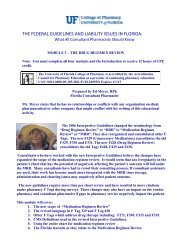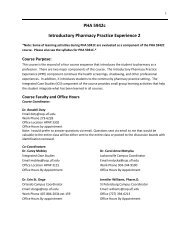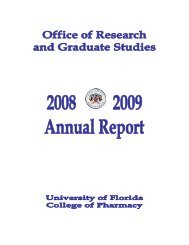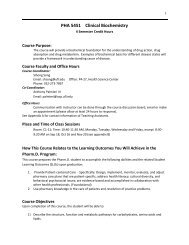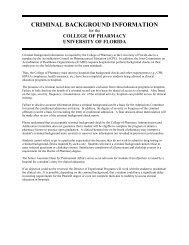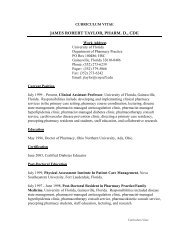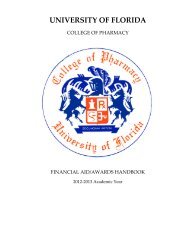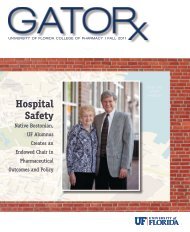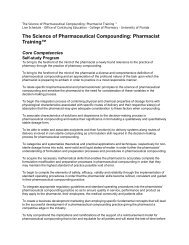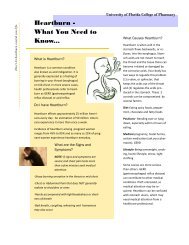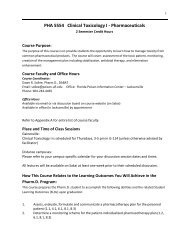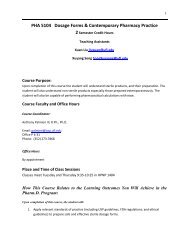INFECTIOUS DISEASE REVIEW Upper Respiratory Tract Infections
INFECTIOUS DISEASE REVIEW Upper Respiratory Tract Infections
INFECTIOUS DISEASE REVIEW Upper Respiratory Tract Infections
Create successful ePaper yourself
Turn your PDF publications into a flip-book with our unique Google optimized e-Paper software.
<strong>INFECTIOUS</strong> <strong>DISEASE</strong> <strong>REVIEW</strong><br />
<strong>Upper</strong> <strong>Respiratory</strong> <strong>Tract</strong> <strong>Infections</strong><br />
A Knowledge-Based Course<br />
The University of Florida College of Pharmacy is accredited by the Accreditation Council for<br />
Pharmacy Education as a provider of continuing pharmacy education.<br />
<strong>Upper</strong> <strong>Respiratory</strong> <strong>Tract</strong> <strong>Infections</strong><br />
Goal: to give an overview for the pharmacist to the presentation of the most common infections and drugs and<br />
immunizations for prevention and/or treatment of these infections.<br />
Objectives: The participants who complete this course should be able to:<br />
1. State the most common microbes found on or within the body<br />
2. List the most common pathogens by site(s) and type of infection<br />
3. Describe the common presenting signs, symptoms, and lab tests used to assess ID entities covered.<br />
4. Differentiate the preferred and alternative antimicrobial agents for the ID entities covered or assigned.<br />
5. Discuss the most common infectious diseases and appropriate antimicrobial usage and undesirable effects of agents<br />
covered.<br />
<strong>Upper</strong> <strong>Respiratory</strong> <strong>Tract</strong> <strong>Infections</strong>: Assessment of Infection, EENT and upper respiratory tract infections (URTIs)<br />
Introduction-<br />
It is essential for the pharmacist assessment of infectious diseases to consider the patients’ overall health status and to make<br />
recommendations to physicians and/or other health professionals. These recommendations should be based on these<br />
findings and knowledge of the preferred drugs and alternatives, as well as complications of the individual infections, with and<br />
without treatment.<br />
I. Principles of Antimicrobial Therapy. Host status, Bugs by site, preferred and alternative agents by organisms, drug failure<br />
and resistance review<br />
Approaching Infectious Diseases (IDs) - Disease states and Drugs that can Mimic IDs include: Cancers (CAs), Autoimmune<br />
diseases, Immune agents, and drug fever<br />
Establishing the presence of Infection - Patient History (Hx), physical and lab findings<br />
History - What are the underlying problems in the patient, e.g. cancer (CA) and chemotherapy, transplant of heart, kidney,<br />
liver, or prosthestic devices, e.g. heart valves, knee or hip joint replacement, COPD, AIDS, elderly, pediatric, acute or chronic<br />
allergies and the history of the present illness (HPI), e.g. did the patient have a cold and cough for the past 2 weeks and a lowgrade<br />
fever? Did the drug history include drugs that predispose to infection? (eg newer immunmodulating agents for<br />
arthritis[Enbrel, Remicade, Orencia and Sustiva] oral corticosteroids and chemo or transplant rejection agents)<br />
Physical - Does the patient have chills, fever, defervescence ( fever “breaking”), local lymphadenopathy or painful/tender<br />
1
nodes of neck, groin, and limbs and/or lymphangitis (AKA "red streaks") and swelling of limbs, adequate urine output ( should<br />
be at least 15-20ml/hr unless dehydrated up to 0.5-1.0ml/kg/hr), fast or slow pulse rate (N=60-80BPM), increased respiratory<br />
rate (N=12-20 rpm) tachypnea >30 rpm; 5-8 K/mm3 with "shift to the left"), Lumbar puncture, sputum (PMNs, epithelial cells), skin and soft tissue<br />
scraping or aspiration (e.g. knee), Throat Strep-lysin and C&S are all procedures that may be needed to establish the presence<br />
of infection. More details on individual lab tests are included in each course section.<br />
Note: The correct answers are listed after each case. To assess your learning you should answer the questions before looking<br />
at the answers.<br />
Case 1. A 56-year old female patient presents to you pharmacy with complaints of fever, productive cough, sore throat,<br />
headache and ear ache. She had a “cold and allergies” the past two weeks. Her oral temperature is 101.4, respiratory rate is<br />
32-36 times per minute, BP is 168/104, pulse is 82 to 90 BPM and she has no energy. She has a history, of high blood pressure<br />
and allergies and rheumatoid arthritis. Please see case questions below:<br />
1. Her meds include a. celecoxib 200mg/day b. prednisone 10mg/day c. lisinopril 10mg daily and d. acetaminophen<br />
500mg one q 6h prn pain (4 doses in the past 24 hours). Which of her meds could suppress her temperature<br />
elevation if she was taking them?<br />
a. a and d<br />
b. b and c<br />
c. c and d<br />
d. b and c<br />
2. Her vital signs suggest<br />
a. no problem;<br />
b. active infection;<br />
c. b and maybe in more than one area of her respiratory system;<br />
d. c and poorly controlled blood pressure if she is taking her meds.<br />
3. You check her lymph nodes on the front and back of her neck and several places are tender. She may have<br />
a. no problem;<br />
b. active infection;<br />
c. b in more than one area;<br />
d. c and she needs acute care<br />
2
4. Which of her meds could have increased her risk of infection? (Use letters in question 1 please.)<br />
5. Your most appropriate action may be to:<br />
a. recommend regular acetaminophen to suppress fever;<br />
b. a and add an antihistamine;<br />
c. refer to primary care clinician;<br />
d. simply recommend increased fluid intake<br />
KEY--- 1-a, 2-c, 3-d, 4-b, 5-c<br />
Normal versus Pathogenic Flora of the body- Table one lists the most common normal and pathogenic organisms found on<br />
and within the body, as well as those body areas that are normally sterile.<br />
Classification of ID Organisms and Sites of Infection<br />
Table 1. Table of Normal Flora and Most Common Pathogens<br />
SITE<br />
External Ear<br />
Middle Ear<br />
Nasal Passages<br />
NORMAL FLORA<br />
Staphylococcus epidermidis<br />
Alpha-hemolytic streptococci<br />
Coliform bacilli<br />
Aerobic corynebacteria<br />
Corynebacterium acnes<br />
Candida species<br />
Bacillus species<br />
NOTE: IN OLDER PATIENTS<br />
EXCESSIVE WAX MAY ALLOW<br />
DIFFERENT FLORA MIX<br />
Sterile (UNLESS EARDRUM NOT<br />
INTACT)<br />
Staphylococcus epidermidis<br />
Staphylococcus aureus<br />
Diphtheroids<br />
Pneumococci<br />
Alpha-hemolytic streptococci<br />
Nonpathogenic Neisseria<br />
species<br />
PATHOGEN<br />
1. Pseudomonas aeruginosa (or other gramnegative<br />
bacilli)-otitis externa primary pathogen!<br />
2. Staphylococcus aureus<br />
3. Streptococcus pyogenes (Group A)<br />
4. Streptococcus pneumoniae<br />
5. Haemophilus influenzae<br />
(in children)<br />
6. Fungi<br />
1. Streptococcus pneumoniae<br />
2. Haemophilus influenzae<br />
(in children)<br />
3. Streptococcus pyogenes<br />
(Group A)<br />
4. Staphylococcus aureus<br />
5. Anaerobic streptococci<br />
6. Bacteroides<br />
7. Other gram-negative bacilli<br />
e.g. M. catarrhalis (Chronic)<br />
Paranasal Sinuses<br />
1. Streptococcus pneumoniae<br />
2. Streptococcus pyogenes (Group A)<br />
3. Haemophilus influenzae<br />
4. Moraxella catarrhalis<br />
5. Klebsiella (or other gram-negative bacilli)<br />
5. Anaerobic streptococci (Chronic sinusitis)<br />
3
SITE<br />
Mouth-NOTE: IN<br />
OLDER PTS. CHECK<br />
FOR DENTURES<br />
AND ABRASIONS<br />
FROM POORLY-<br />
FITTED DENTURES;<br />
ALSO DRY MOUTH<br />
(XEROSTOMIA),<br />
GINGIVAL<br />
HYPERPLASIA AND<br />
LACK OF DENTAL<br />
HYGIENE MAY<br />
PREDISPOSE TO<br />
INFECTIONS OF<br />
GUMS, TEETH AND<br />
BONES<br />
Pharynx &<br />
Tonsils: NOTE, IN<br />
OLDER PTS. THE<br />
USAGE OF<br />
MOUTHWASHES,<br />
INHALED and nasal<br />
CORTICOSTEROIDS<br />
MAY PREDISPOSE<br />
TO infection with<br />
monilial fungi, eg<br />
Candida<br />
(THRUSH) WITH<br />
Advair, Symbicort,<br />
VANCERIL,<br />
AZMACORT,<br />
AEROBID,<br />
DECADRON, ETC.<br />
BY INHALER,<br />
UNLESS<br />
THOROUGH<br />
GARGLING IS<br />
ENCOURAGED<br />
AFTER EACH<br />
INHALATION via<br />
Aerobic corynebacteria 6. Staphylococcus aureus (Chronic sinusitis)<br />
7. Mucor, Asperigillus (especially in diabetics)<br />
NORMAL FLORA<br />
Alpha-hemolytic streptococci<br />
Enterococci<br />
Lactobacilli<br />
Staphylococci<br />
Fusobacteria<br />
Bacteroides species<br />
Diphtheroids<br />
Alpha-hemolytic streptococci<br />
Neisseria species<br />
Staphylococcus epidermidis<br />
Staphylococcus aureus<br />
(small numbers)<br />
Pneumococci<br />
Nonhemolytic (gamma)<br />
streptococci<br />
Diphtheroids<br />
Coliforms<br />
Beta-hemolytic streptococci<br />
(not Group A)<br />
Actinomyces israelii<br />
Haemophilus species<br />
Marked predominance of one<br />
organism may be clinically<br />
significant even if it is a normal<br />
inhabitant.<br />
PATHOGENIC FLORA<br />
1. Herpes viruses<br />
2. Candida albicans<br />
3. Leptotrichia buccalis (Vincent's infections)<br />
4. Bacteroides<br />
5. Mixed anaerobes<br />
6. Treponema pallidum<br />
7. Actinomyces<br />
Throat<br />
1. <strong>Respiratory</strong> viruses<br />
2. Streptococcus pyogenes (Grp A-beta hemolytic)<br />
3. Neisseria meningitidis or gonorrhea<br />
4. Leptotrichia buccalis (Vincent's infection)<br />
5. Candida albicans<br />
6. Corynebacterium diphtheriae<br />
7. Bordetella pertussis<br />
4
lungs or nostrils<br />
WITH PINCH OF<br />
SALT IN HALF-<br />
GLASS WARM<br />
WATER or plain<br />
water.<br />
SITE<br />
Larynx, trachea, &<br />
bronchi-NOTE:<br />
COPD PTS. HAVE<br />
IMPAIRED HOST<br />
DEFENSE AND<br />
TEND TO HAVE<br />
STREP, H-FLU ,<br />
STAPH AND KLEB<br />
COLONIZATIONS<br />
THAT READILY<br />
BECOME<br />
PATHOGENIC<br />
WITH THE<br />
COMMON COLD,<br />
flu OR ALLERGY<br />
ATTACKS<br />
Pleura<br />
SITE<br />
Lungs<br />
NORMAL FLORA<br />
Sterile<br />
Sterile<br />
NORMAL FLORA<br />
Sterile-SEE COPD NOTE ABOVE<br />
PATHOGENIC FLORA<br />
Larynx, Trachea, & Bronchi<br />
1. <strong>Respiratory</strong> viruses<br />
2. Streptococcus pneumoniae<br />
3. Haemophilus influenzae<br />
4. Streptococcus pyogenes (Group A)<br />
5. Corynebacterium diphtheriae<br />
6. Staphylococcus aureus<br />
7. Gram-negative bacilli<br />
1. Staphylococcus aureus<br />
2. Streptococcus pneumoniae<br />
3. Haemophilus influenzae<br />
4. Gram-negative bacilli<br />
5. Anaerobic streptococci<br />
6. Bacteroides<br />
7. Streptococcus pyogenes (Group A)<br />
8. Mycobacterium tuberculosis<br />
9. Actinomyces, Nocardia<br />
10. Fungi<br />
PATHOGEN<br />
Pneumonia<br />
1. <strong>Respiratory</strong> viruses<br />
2. Mycoplasma pneumoniae (late)<br />
3. Strep. pneumoniae (early)<br />
4. Haemophilus influenzae<br />
5. Staphylococcus aureus<br />
6. Klebsiella (or other gram-negative bacilli)<br />
7. Streptococcus pyogenes (Group A)<br />
8. Rickettsia<br />
9. Chlamydia psittaci<br />
10. Mycobacterium tuberculosis<br />
5
SITE<br />
Stomach Small<br />
intestine: NOTE-<br />
10 TO 15% OF<br />
PATIENTS ALSO<br />
HAVE<br />
EUBACTERIUM<br />
LENTUM AS<br />
NORMAL FLORA-<br />
THESE PTS. MAY<br />
REQUIRE HIGHER<br />
DIGOXIN DOSES,<br />
DUE TO THE<br />
INACTIVATION OF<br />
DIGOXIN BY EU.<br />
LENTUM; WATCH<br />
FOR DIGOXIN<br />
TOXICITY WHEN<br />
BIAXIN,<br />
ERYTHROMYCIN<br />
OR<br />
TETRACYCLINES<br />
ARE GIVEN TO A<br />
PATIENT<br />
STABILIZED ON A<br />
HIGHER DOSE OF<br />
DIGOXIN; ALSO BE<br />
AWARE THAT 40-<br />
70% OR MORE OF<br />
OLDER PTS. ARE<br />
ACHLORHYDRIC<br />
and H-2 blockers<br />
and PPIs may<br />
predispose them<br />
to higher risk of<br />
RTIs<br />
Colon<br />
NORMAL FLORA<br />
Sterile<br />
Sterile in one-third<br />
Scant bacteria in others<br />
Escherichia coli<br />
Klebsiella<br />
Enterobacter<br />
Enterococci<br />
Alpha-hemolytic streptococci<br />
Staphylococcus epidermidis<br />
Diphtheroids<br />
Colon has---><br />
Abundant bacteria<br />
Bacteroides species<br />
Escherichia coli<br />
Klebsiella<br />
Enterobacter<br />
Paracolons<br />
Proteus species<br />
Enterococci (Group D<br />
streptococci)<br />
Yeasts<br />
(stool is 1/2 or more bacteria by<br />
weight)<br />
11. Anaerobic streptococci<br />
12. Bacteroides<br />
13. Pneumocystis carinii (AIDS)<br />
14. Fungi (AIDS and immunecompr.)<br />
15. Legionella pneumophilia<br />
16. Legionella micdadei (L. pittsburgensis)<br />
PATHOGENS<br />
Gastrointestinal <strong>Tract</strong><br />
1. Gastrointestinal viruses<br />
2. Salmonella<br />
3. Escherichia coli<br />
4. Shigella<br />
5. Campylobacter (vibrio) fetus<br />
6. Yersinia enterocolitica<br />
7. Staphylococcus aureus<br />
8. Vibrio cholerae<br />
9. Vibrio parahaemolyticus<br />
10. Treponema pallidum (anus)<br />
11. Neisseria gonorrhoeae (anus)<br />
12. Candida albicans<br />
13. Clostridium difficile<br />
6
Urethra, Male-<br />
NOTE; USE OF A<br />
TEXAS or Condom<br />
CATHETER<br />
INCREASES RISK<br />
OF UTI TO THAT<br />
OF INDWELLING<br />
CATHETERS IN<br />
BOTH SEXES<br />
Prostate<br />
SITE<br />
Urethra, Female<br />
and<br />
vagina<br />
Staphylococcus aureus<br />
Staphylococcus epidermidis<br />
Enterococci<br />
Diphtheroids<br />
Achromobacter wolffi (Mima)<br />
Haemophilus vaginalis<br />
Bacillus subtilis<br />
Sterile<br />
NORMAL FLORA<br />
Lactobacillus (large numbers)<br />
Coli-aerogenes<br />
Staphylococci<br />
Streptococci (aerobic and<br />
anaerobic)<br />
Candida albicans<br />
Bacteroides species<br />
Achromobacter wolffi (Mima)<br />
Haemophilus vaginalis<br />
Male Genital <strong>Tract</strong><br />
Seminal Vesicles<br />
1. Gram-negative bacilli, mainly E.coli<br />
2. Neisseria gonorrhoeae<br />
Epididymis<br />
1. Gram-negative bacilli<br />
2. Neisseria gonorrhoeae<br />
3. Chlamydia<br />
4. Mycobacterium<br />
Prostate Gland<br />
1. Gram-negative bacilli, E. coli, Proteus<br />
2. Neisseria gonorrhoeae<br />
PATHOGENIC FLORA<br />
Female Genital <strong>Tract</strong><br />
Vagina<br />
1. Trichomonas vaginalis<br />
2. Candida albicans<br />
3. Neisseria gonorrheae<br />
4. Streptococcus pyogenes (Group A)<br />
5. Haemophilus vaginalis<br />
6. Treponema pallidum<br />
7. Staphylococcus aureus<br />
Uterus<br />
1. Anaerobic streptococci<br />
2. Bacteroides<br />
3. Neisseria gonorrheae<br />
4. Clostridia<br />
5. Escherichia coli (or other gram-negative<br />
bacilli)<br />
6. Herpes virus, type II (cervix)<br />
7. Streptococcus pyogenes (Group A)<br />
8. Streptococcus, Groups B & C<br />
9. Treponema pallidum<br />
10. Staphylococcus aureus<br />
11. Enterococcus<br />
Fallopian Tubes<br />
1. Neisseria gonorrhoeae<br />
2. Gram-negative bacilli<br />
3. Anaerobic streptococci<br />
4. Bacteroides<br />
5. Chlamydia<br />
7
Urine, continent<br />
patients;<br />
incontinent pts.<br />
have 3+ to 4+<br />
bacteriuria which<br />
may be protective<br />
colonization,<br />
rather than clinical<br />
infection of E. coli<br />
and/or Proteus;<br />
stone-formers<br />
typically have<br />
Proteus<br />
Peritoneum<br />
Bones-NOTE: IN<br />
OLDER PTS., WITH<br />
HX HIP<br />
FX/NAILING/BALL<br />
REPLACEMENT OR<br />
OPEN STAGE IV<br />
DECUBITUS, ESP.<br />
IF<br />
MALNOURISHED,<br />
STAPH<br />
OSTEOMYELITIS IS<br />
MORE LIKELY<br />
SITE<br />
Joints<br />
Staphylococci, coagulase<br />
negative<br />
Diphtheroids<br />
Coliform bacilli<br />
Enterococci<br />
Proteus species<br />
Lactobacilli<br />
Alpha- and Beta-hemolytic<br />
Streptococci<br />
Sterile<br />
Sterile<br />
NORMAL FLORA<br />
Sterile<br />
Urinary <strong>Tract</strong><br />
1. Neisseria gonorrheae (urethra)<br />
2. Escherichia coli (or other gram-<br />
negative bacilli)<br />
3. Staphylococcus aureus and epidermidis<br />
4. Enterococcus<br />
5. Candida albicans<br />
6. Chlamydia (urethra)<br />
7. Treponema pallidum (urethra)<br />
8. Trichomonas vaginalis (urethra)<br />
Peritoneum<br />
1. Gram-negative bacilli<br />
2. Enterococcus<br />
3. Bacteroides<br />
4. Anaerobic streptococci<br />
5. Clostridia<br />
6. Streptococcus pneumoniae<br />
7. Streptococcus Group B<br />
Bones (Osteomyelitis)<br />
1. Staphylococcus aureus (>30yo)<br />
2. N. gonorrhoeae (30)<br />
2. Streptococcus pyogenes<br />
(Group A)<br />
3. Neisseria gonorrhoeae (
Eye-NOTE: DRY<br />
EYE IN OLDER<br />
PATIENTS<br />
PREDISPOSES TO<br />
BACTERIAL<br />
CONJUNCTIVITIS<br />
AND BLEPHARITIS;<br />
USE OF ARTIFICIAL<br />
TEARS GTTS ii QID<br />
DECREASES<br />
FREQUENCY OF<br />
EYE<br />
INFECTIONS(Coop<br />
er JW Cons Pharm<br />
1988); SUSPECT<br />
MRSA IN NURSING<br />
HOME PTS. WITH<br />
CHRONIC<br />
BACTERIAL<br />
EYE/LID<br />
INFECTIONS<br />
SITE<br />
Spinal Fluid<br />
SITE<br />
Blood-NOTE:<br />
BACTEREMIA IS<br />
MORE COMMON<br />
Usually sterile<br />
Occasionally small numbers<br />
of diphtheroids and coagulase-<br />
negative staphylococci<br />
NORMAL FLORA<br />
Sterile<br />
NORMAL FLORA<br />
Sterile<br />
8. Mycobacterium tuberculosis and<br />
other mycobacteria<br />
9. Fungi<br />
Eye (Cornea and Conjunctive)<br />
1. Herpes and other viruses<br />
2. Staphylococcus aureus-most common bacterial<br />
infection<br />
3. Neisseria gonorrheae (newborns)<br />
4. Haemophilus aegyptius<br />
(Koch-Weeks bacillus)<br />
5. Streptococcus pneumoniae<br />
6. Haemophilus influenzae<br />
(in children)<br />
7. Moraxella lacunate<br />
8. Pseudomonas aeruginosa<br />
9. Other gram-negative bacilli<br />
10. Chlamydia trachomatic<br />
(trachoma)<br />
11. Chlamydia (inclusion conjunctivitis)<br />
12. Fungi<br />
PATHOGENS<br />
Meninges<br />
1. Viral agents (enterovirus, mumps, herpes<br />
simples, and others)<br />
2. Neisseria meningitidis<br />
3. Haemophilus influenzae (in children)<br />
4. Streptocococcus pneumoniae<br />
5. Streptococcus Group B (infants less than 2<br />
months old)<br />
6. Escherichia coli (or other gram-negative bacilli)<br />
7. Strep. pyogenes (Group A)<br />
8. Mycobacterium tuberculosis<br />
10. Cryptococcus neoformans and other fungi<br />
11. Listeria monocytogenes<br />
12. Enterococcus (neonatal period)<br />
13. Treponema pallidum<br />
14. Leptospira<br />
PATHOGENS<br />
Blood (Septicemia) New born Infants<br />
1. Escherichia coli (or other gram-negative bacilli)<br />
2. Streptococcus Group B<br />
3. Staphylococcus aureus<br />
9
IN OLDER PTS.<br />
WITH<br />
PNEUMONIAS,<br />
DECUBITI, UTIs,<br />
INDWELLING<br />
CATHETERS,<br />
ESPECIALLY IF<br />
MALNUTRITION IS<br />
ALSO PRESENT.<br />
Self Assessment Questions-<br />
1. The patient with excessive ear wax may have<br />
a. more risk of ear infections<br />
b. less risk of ear infections<br />
4. Strep. pyogenes (Group A)<br />
5. Enterococcus<br />
6. Listeria monocytogenes<br />
7. Streptococcus pneumoniae<br />
Children<br />
1. Streptococcus pneumoniae<br />
2. Neisseria meningitidis<br />
3. Haemophilus influenzae<br />
4. Staphylococcus aureus<br />
5. Strep. pyogenes (Group A)<br />
6. Escherichia coli) or other gram-negative bacilli)<br />
Adult<br />
1. Escherichia coli (or other gram-negative bacilli)<br />
2. Staphylococcus aureus<br />
3. Streptococcus pneumoniae<br />
4. Bacteroides<br />
5. Strep. pyogenes (Group A)<br />
6. Neisseria meningitidis<br />
7. Candida albicans<br />
8. Neisseria gonorrheae<br />
9. Other Candida species<br />
2. A patient is using a. Nasacort nasal steroid and b. Azmacort inhaled steroid. Which can increase the risk of “thrush”<br />
a. a only<br />
b. b only<br />
c. both a and b.<br />
d. neither a nor b.<br />
3. A patient with COPD is a greater risk of respiratory tract infections due to their<br />
a. COPD<br />
b. colds or flu<br />
c. allergies<br />
d. all, a-c<br />
4. A patient taking digoxin in a higher than normal dose to get therapeutic blood levels is at risk of what change in their<br />
blood levels?<br />
10
a. increase with diarrhea<br />
b. decrease with antiinfectives<br />
c. a and increase with antiinfectives, especially macrolides and tetracyclines<br />
d. no change<br />
5. A patient taking H-2 blockers, eg ranitidine and/or PPIs, eg omeprazole is at risk of increased infections of what type<br />
a. RTIs<br />
b. UTIs<br />
c. skin<br />
d. bone<br />
KEY-> 1-a, 2-c, 3-d, 4-c, 5-a<br />
EENT and <strong>Upper</strong> respiratory tract infections. Includes Pink eye, colds, flu, pharyngitis, sinusitis, otitis media (and allergies).<br />
The following is from JW Cooper, Geriatric drug therapy, by permission.<br />
EYE <strong>Infections</strong> (ENT=ears, nose and throat infections covered in upper respiratory [URI] section)<br />
Conjunctivitis ("Pink-eye") is a general or nonspecific term that refers to inflammation of the conjunctiva. The<br />
conjunctiva is a thin mucous membrane that covers the posterior surface of the eyelids and the whites of the eye.<br />
The conjunctiva is usually adequately hydrated by the blink response and tears. Please see viral, bacterial and<br />
allergic conjunctivitis types in figures 1, 2 and 3 below.<br />
The conjunctiva may become thinner with aging, which leads to drying of the eye surface and the eye becomes<br />
increasingly more sensitive to irritants; conjunctivitis becomes a common problem. The patient may present with<br />
diffuse redness in one or both eyes, complaints of irritation, itching and tearing or exudation that may be purulent.<br />
If matting of the eyelids, especially on arising is noted on arising from slumber, bacterial infection is often present.<br />
Vision is usually not impaired, unless itching of the eye has abraded the corneal surface. Guarding of the eyes<br />
from light (photophobia) should always raise the suspicion of eye damage that requires referral to an eye care<br />
specialist (i.e. optometrist or ophthalmologist) and recommendation to cover the affected eye(s) with a patch.<br />
Conjunctivitis can be caused by a variety of allergens and infectious and noninfectious agents such as bacteria,<br />
viruses, fungi, toxins, and irritating chemicals. The most common causes of conjunctivitis in the elderly are<br />
bacterial, viral, and allergic.<br />
Figure 1- Allergic Conjunctivitis-note swollen lids and redness of white of eyes-will usually also have itching and<br />
burning of eyes<br />
11
.<br />
Allergic Conjunctivitis<br />
Courtesy of http://www.aaaai.org<br />
Figure 2-Viral Conjunctivitis-note diffuse redness in both eyes with NO matting<br />
Viral Conjunctivitis<br />
Picture courtesy of www.eyedrops.info<br />
Figure 3- Bacterial Conjunctivitis-Note matting of both eyes<br />
12
Bacterial Conjunctivitis<br />
picture courtesy of www.eyedrops.info<br />
ASSESSMENT<br />
Consider patient referral to an ophthalmologist or to the emergency room. You may want to check the patient for<br />
photophobia (i.e., cannot look at light source without squinting/closing eyes) and for any irregularity of image<br />
reflection on the surface of the cornea. A fluorescent light fixture is a good source of a "rectangular" light image<br />
that you can have the patient look at and observe the reflection of the shape of the light. If either abnormality is<br />
present, get the patient to an ophthalmologist quickly. Call for an appointment STAT while the patient is with you.<br />
1. In dry eyes WITHOUT INFECTION or corneal damage, artificial tears are good for long-term use to decrease the<br />
frequency of eye infections and allergic response. Drugs that are anticholinergic in primary or side effects may<br />
worsen dry eye conditions, e.g., antihistamines and anticholinergics for incontinence, such as cetirizine or<br />
oxybutinin. Make sure that a polymer is part of the formulation, e.g. methylcellulose, or PVP to prolong contact of<br />
the drop with the surface of the eye. Examples are: Adsorbatear, Liquifilm, Tearisol, etc. Dose is 2gtts in each eye<br />
QID CONTINUOUS. NOTE: The regular instillation of artificial tears with this regimen has been shown to reduce the<br />
frequency of bacterial conjunctivitis (JW Cooper, Cons Pharm l988; 3:83.). The use of topical cyclosporine (Restasis)<br />
emulsion for chronic dry eyes is much more expensive and may NOT work if topical NSAIDs or corticosteroids are<br />
in use. Topical Cyclosporine drops (Restasis) should NOT be used in active eye infections.<br />
The need for an antibiotic eye preparation more often than quarterly to semi-annually with change of seasons<br />
suggests the need for regular use of artificial tears. Visual inspection of the eyes that finds apparent dryness for<br />
more than several days at a time, also raises the question of need for continual usage of an artificial tear/polymer<br />
preparation. BE SURE TO APPLY artificial tears LAST or at least 30-60 minutes away from glaucoma topical eye<br />
preparations to prevent occlusion of the eye absorbing surface by the polymer in the artificial tears.<br />
2. For allergic, itchy eyes, artificial tears with a topical vasoconstrictor is preferable, e.g. Visine. In addition, the<br />
younger patient may need diphenhydramine 25mg HS or chlorpheniramine maleate (CTM) 2mg once to BID to<br />
TID for allergy; a non-sedating antihistamine such as loratidine (Claritin/Alavert) 10mg daily may be preferable<br />
in older patients or those who cannot tolerate the sedation, INCREASED FALL RISK and drying side effects of the<br />
13
older antihistamines to include the active metabolite of hydroxyzine (ie cetirizine-Zyrtec). Baby shampoo,<br />
several drops on a clean warm water-soaked cloth may help to keep allergens washed away from lid surfaces<br />
and the orbital area of eye. Be sure to recommend that a clean cloth be used for each washing of the<br />
periorbital area, and different portions of the cloth used for each eye, to avoid cross-contamination. See figure<br />
1.<br />
3. For a dry, allergic, or infectious red eye, short-term, days to 2 weeks, therapy of topical glucocorticoids (GC)<br />
may be acceptable. If the patient has a history of glaucoma,it is essential that the intraocular pressure be<br />
checked if therapy is to last more than two weeks. YOU MUST ALWAYS use a topical antitinfective in infectious<br />
red eye if a topical GC is used. Use beyond this period of time, increases the risk of higher intraocular pressure<br />
(IOP) and cataract formation. Agents used include prednisolone, hydrocortisone, dexamethasone and<br />
fluoromethalone. An alternative to steroids is levocabastine HCl (Livostin), an H-1 antihistamine for temporary<br />
relief of seasonal allergic conjunctivitis. Livostin dose is one drop in affected eye(s) BID to QID prn. Contains<br />
benzalkonium chloride which may damage soft contact lenses; most persons cannot wear any contact lenses<br />
when conjunctivitis occurs. See figures 1, 2 and 3.<br />
4. Bacterial conjunctivitis (BC) AKA "Pink Eye" is frequently the result of staphylococci, streptococci, both<br />
staph and strep or gram-negative bacteria. BC is common after or with allergic conjunctivitis and is<br />
characterized by a purulent discharge that produces matting of the lids. (see figure 3) The patient usually<br />
complains of difficulty in opening the eyelids in the morning because of dried pus literally gluing the eyelids<br />
shut. Discomfort from bacterial conjunctivitis is usually mild despite marked inflammatory changes because of<br />
the relative lack of pain fibers in the conjunctiva.<br />
Bacterial conjunctivitis is usually self-limited, lasting 7-14 days without treatment and 3 to 4 days with<br />
treatment. A culture of the eye(s) is not considered necessary because conjunctivitis is self-limited. However, a<br />
culture should be obtained in persistent and/or serious infectious problems that last for more than 2 weeks of<br />
topical antibiotic therapy.<br />
NOTE: Blepharitis (Lid infection) may also be present and respond better to the cleansing and use of an<br />
ophthalmic ointment applied BID (e.g. polymyxin or bacitracin) to the affected lid(s). Avoid neomycin<br />
containing eye preparations (e.g., Neosporin) due to risk of sensitization to neomycin and subsequent allergy to<br />
all aminoglycosides (AGs). Chronic bacterial blepharitis is usually a resistant staph infection that causes loss of<br />
eyelashes and may require low-dose suppressive antimicrobial therapy (e.g. oral erythromycin 250mg or<br />
doxycycline 100mg PO daily) to decrease the frequency of acute infections that seed both the lid and<br />
conjunctiva. An external stye (hordeolum) is best treated with hot compresses which will cause it to drain<br />
spontaneously. An internal stye requires hot packs AND a penicillinase resistant pencicillin (PRP) or first<br />
generation cephalosporin, e.g. clox- and dicloxacillin or cephalexin for 7-10 days, as internal styes rarely drain<br />
spontaneously.<br />
A very conservative approach that can be recommended in suspected BC is a sterile normal saline eye wash<br />
(e.g. Collyrium) four times a day for 48 hours before resorting to instillation of any prescribed ophthalmic<br />
medication. RUN hot soapy water in eye cup between uses to avoid self-reinocculation with bacteria.<br />
If signs of redness and symptoms persist longer than 2 days a topical antibacterial (e.g. sulfacetamide) may<br />
then be initiated. In the case of red eye with infection, evidenced by morning matting at corners of eyes, a<br />
sulfacetamide 10% eye drops with baby shampoo cleaning QID and artificial tears used regularly may decrease<br />
incidence of reinfections.<br />
14
BC in CONTACT LENS USERS<br />
BC in this group tends to be predominantly Ps. aeruginosa, which has to be aggressively treated with<br />
tobramicin + pipracillin or ticarcillin eye drops q 15-60 minutes for 24-72 hours or FQs ciprofloxacin (Cipro),<br />
ofloxacin (Oflox), levofloxacin (Quixin), moxifloxacin (Vigamox) or gatifloxacin (Zymar) eye drops same schedule<br />
ATC (around-the clock) then slow reduction and lengthening of dosage interval over days to weeks with<br />
ophthalmologist re-check every 1-2 weeks or recurrence of symptoms.<br />
Watch long-term use of any antibacterial if eyes are still infected/reddened. Intermittent use is best for 5-10<br />
days; if eyes are still red or infected the patient may need C&S, a change to another anti-bacterial, and/or<br />
artificial tear chronic use. Check for allergy history, especially if sulfonamide or aminoglycoside allergic<br />
reaction has been previously noted.<br />
Start BC treatment with sodium sulfacetamide 10%. If sulfas do not clear the infection, Try the macrolide<br />
azithromycin 1% (AzaSite) before Polytrim (TMP-polymyxin) or Polysporin (Bacitracin-polymixin), AVOID<br />
neomycin with bacitracin/polymyxin (Neosporin) due to neomycin hypersensitivity to AGs. If an AG is<br />
needed then use AGs gentamicin (Garamycin), then tobramycin (Tobrex) may be considered as eye<br />
antiinfectives. Reserve the fluoroquinolone eye drops for resistant infections that have not responded to all<br />
the other mentioned agents; FQs rapidly induce resistant strains, so should be reserved as last resort to retain<br />
their efficacy. A 10-14 day stop order is essential to monitor effectiveness as well as the possible emergence of<br />
resistant infections.The newest FQs are levofloxacin (Quixin) and moxifloxacin (Vigamox) and gatifloxacin<br />
(Zymar) .<br />
BC is CONTAGIOUS!! Bacterial conjunctivitis is extremely contagious and can be spread by direct contact, most<br />
commonly from hand-to-eye. Hands should be washed before and after application of drops or ointment, and<br />
the tip of the tube or bottle should not touch the eye surface or lid. If contact does occur, then immediately<br />
washing the surface with warm soapy water is essential to minimize spread of the contagion.<br />
Topical steroids may retard infection/wound healing once inflammation is clear. Their legitimate usage is<br />
primarily for post-cataractectomy care. Also, they increase glaucoma/cataract risk with prolonged usage (>2-4<br />
weeks). The addition of corticosteroids (i.e., hydrocortisone) to a topical antibiotic does not increase the<br />
effectiveness of the preparation for bacterial conjunctivitis nor speed the resolution process of the infection.<br />
The combination of steroid-antibacterial preparations (e.g. Cortisporin) is not usually recommended as the<br />
corticosteroid may reduce resistance to bacterial, viral and fungal infections and may mask the signs of a<br />
hypersensitivity reaction to the antibacterial.<br />
Self-Assessment<br />
Case 2-<br />
A 57 year-old female presents to your pharmacy with complaints of (c/o) dry, itchy eyes. On review of her<br />
medication profile for the last 6 months, you notice that she has had several topical antiinfective Rxs for<br />
blepharitis and conjunctivitis.<br />
Self Assessment Questions-<br />
1. What other physical assessments should you do before making a recommendation?<br />
a. check for eye glasses or contacts matting of eyelids and pink eye<br />
b. check for photophobia<br />
c. check her history of colds and allergies<br />
d. all of the above<br />
15
2. You have completed the assessment in question 1. She does have eyelid matting, had a cold last week and<br />
has chronic allergies which she has self-treated with CTM. You assess that she needs medications to prevent<br />
eye and lid infections recurrence. Which of the following would you recommend?<br />
a. artificial tears without polymer<br />
b. a with polymer – two drops four times daily.<br />
c. cleansing eye lids with baby shampoo and clean cloth at least daily<br />
d. b and c and referral to her eye care professional<br />
3. The patient takes your recommendations and returns the next week wearing dark glasses. She says that she<br />
cannot look at lights without squinting and eye pain. Which finding in question 1 does this suggest?<br />
4. What is your next step with this patient?<br />
a. offer an antibacterial for her eye<br />
b. offer oral and topical decongestants<br />
c. offer to call her eye care professional<br />
d. a and b<br />
key: 1-D, 2-D, 3-B, 4-C<br />
Viral Eye <strong>Infections</strong> (see viral conjunctivitis in figure 2 )<br />
Topical antivirals (Herplex, Vira-A, Viroptic) are for short-term Herpes simplex conjunctivitis only. Many viral<br />
organisms may cause viral conjunctivitis. This type of conjunctivitis may be associated with other viral<br />
infections such as viral pharyngitis. Some viruses cause infection of the cornea (keratitis) and the conjunctiva<br />
simultaneously. The viral forms of conjunctivitis are usually bilateral with red eyes, but with a clear drainage<br />
and less exudation than the bacterial forms of conjunctivitis. Herpes simplex is the most common virus for<br />
which there is a specific treatment for viral conjunctivitis (idoxuridine[ IDU, Herplex] for IDU-resistant herpes<br />
vidaribine (Vira-A) and for Vira-A resistant herpes, trifluridine (Viroptic). Herpes zoster opthalmicus is treated<br />
with famciclovir (Famvir) 500mg TID or valacyclovir (Valtrex) 1gTID for 10 days or IV acyclovir to prevent loss of<br />
sight in the affected eye.<br />
Treatment: Cool compresses and vasoconstrictor drops (i.e., naphazoline) may provide some symptomatic<br />
relief. Symptoms generally resolve within 7-10 days in healthy individuals with or without specific antivirals.<br />
Meticulous hygiene is necessary to avoid transmission of viral conjunctivitis. Hand washing by the patient and<br />
health care providers who come in contact with the patient is essential in avoiding transmission of this VERY<br />
contagious condition. Ophthalmologic consult is needed for topical antiviral (eg Stoxil) use longer than 21 days.<br />
ALLERGIC Conjunctivitis and Eye <strong>Infections</strong> (see figure 1)<br />
Topical cromolyn (Crolom), lodoxamine (Alomide), nedocromil (Alocril) and pemirolast (Alamast) are mast cell<br />
stabilizers for chronic allergic conjunctivitis, not for acute attacks. They may worsen an acute attack. Other<br />
alternatives are mast cell stabilizer/antihistamines , azelastine (Astelin/Optivar), epinastine (Elestat), ketotifen<br />
(Zaditor) and olapatadine (Patanol), the H-1 antihistamines emedastine (Emadine), livocabastine (Livostin) , and<br />
the NSAID ketorolac (Acular) and other NSAIDs (although not approved for this usage-be sure to check for ASA<br />
allergy). Topical steroids are not recommended for allergic conjunctivitis due to risk of glaucoma and cataracts<br />
with long-term use. Patients with refractory chronic allergic eye problems may require oral antihistamines to<br />
suppress the allergic eye process. (Medical Letter 26 Apr 2004; 46:35-6).<br />
Never use Chlormycetin (chloramphenicol) eye or topical (Elase/Chlormycetin) preparation for prolonged<br />
16
periods (> 2 weeks) as aplastic anemia has been reported via these routes.<br />
Topical Aminoglycosides (gentamicin, neomycin or tobramycin) may add to systemic aminoglycoside levels if<br />
peak and/or trough blood levels are being done. Cross-allergenicity between topical and injectable<br />
aminoglycosides (e.g. neomycin, streptomycin, gentamicin, tobramycin, amikacin and netilmicin.<br />
CASE-3<br />
H.P. a 52 year-old female with recurrent bacterial conjunctivitis developed swollen, reddened eyes after<br />
neomycin/polymyxin/bacitracin (Neosporin) Ophthalmic drops usage for 2 days. Six months later she required<br />
a course of injectable tobramycin for a pseudomonal UTI and immediately broke out in a florid macular itching<br />
rash with the first dose. Even though her chart had AMINOGLYCOSIDE allergy stamped on the front, the prior<br />
exposure to the aminoglycosides neomycin in Neosporin and tobramycin did not prevent a re-exposure to<br />
these drops. On the first instillation of Tobrex eye drops, she developed an anaphylactoid reaction, which<br />
required intravenous steroids.<br />
1. What eye drop would you recommend for her next BC?<br />
a, gentamicin<br />
b. ciprofloxacin<br />
c. TMP<br />
d. polymycin-bacitracin<br />
2. She now has an internal stye. What do you recommend?<br />
a. hot compresses<br />
b. an oral PRP or first generation cephalosporin<br />
c. a and b<br />
d. neomycin/bacitracin/polymyxin (Neosporin)<br />
3. She is asking for contact lens to replace her eyeglasses. What do you recommend?<br />
a. a local eye care professional<br />
b. a preventive antiinfective eye drop<br />
c. a continuance of her eye glasses<br />
d. none of the above<br />
Key: 1-b, 2-c, 3-a<br />
Monitoring <strong>Upper</strong> <strong>Respiratory</strong> <strong>Tract</strong> <strong>Infections</strong> (URTIs) (Nose, sinus, ears and throat problems.<br />
ACUTE URTIs<br />
In acute problems an oral temperature is essential, with no hot or cold beverages 10-15 minutes before taking<br />
temperature. Remember that in older persons, the baseline oral temperature may be 95-97 degrees. Also<br />
watch for acetaminophen, non-acetyl salicylate, NSAID or oral glucocorticoid usage masking febrile state.<br />
Differential Assessment- always check throat, ears and sinuses together<br />
In the presence of sinusitis, with facial fullness and frontal headache with even slight temperature elevation,<br />
there is a great likelihood of bacterial infection in the sinus area, requiring the same antibiotics as you would<br />
see in otitis media.<br />
In the patient with sore throat and/or sub-mandibular lymphadenopathy (tender to touch and palpable<br />
17
anterior and/or posterior chain of nodes on the front and back of throat), any temperature elevation is usually<br />
an indication of possible strep throat. Use office strep lysin test to confirm. Keep in mind that the strep lysin<br />
has only about 60% sensitivity (i.e. true positive in strep disease) and 60-95% specificity ( true negative in<br />
health, i.e. if strep not present). About half with a positive strep lysin are actually infected; the rest are strep<br />
carriers who can give the disease to others, but may NOT be acutely infected. Symptomatic contacts of infected<br />
patients should also probably be evaluated for strep throat.<br />
Acute Pharyngitis-inflammatory process of pharynx and tonsils (Waldeyer's ring) "sore throat" NOTE: always<br />
check ears and sinuses when a patient complains of (c/o) sore throat!<br />
Pharyngitis is more common in cold and flu seasons (may precede cold)<br />
CONCEPT: Some 70-90% or more of sore throats are viral (at least to start).<br />
Viral bugs - rhinovirus, parainfluenza, coronavirus, adenovirus, Herpes simplex and influenza.<br />
Viral pharyngitis Symptoms-nasal Symptoms and cough usually present, sore throat may not be main<br />
complaint but has "cold" and/or hay fever or allergy ; rarely systemic complaints of muscle or joint aches (e.g.<br />
arthralgias or myalgias) unless its the flu<br />
NOTE: VIRAL can quickly go to bacterial sore throat in immune compromised pts.; more slowly or if viral<br />
precedes (always suspect if viral lasts longer than 2-3 days) or low-grade fever starts, with anterior chain<br />
lymphadenopathy, or stomach ache in younger as well as older patients.<br />
Bacterial bugs - S. pyogenes, H. flu, Chlamydia or Mycoplasma pneumoniae, N. gonorrhea (if STD check GU &<br />
GI also)<br />
Bacterial pharyngitis Symptoms - Sore throat primary complaint, painful cervical lymphadenopathy (swollen<br />
anterior neck chain nodes; posterior also if OM/Sinusitis), elevated WBC count with "Shift to the left" and fiery<br />
red throat with exudate on pharynx and tonsil/adenoids. In children and some adults stomach pain may be a<br />
frequent complaint with Strep throat. See picture below for classic appearance.<br />
Differentiate Strep pharyngitis by rapid screening (Strep lysin), but only 60-95% sensitivity (positive in disease<br />
and 90-95 % specificity (negative in healthy state)-- and throat culture for Strep: NOTE only half of positive pts.<br />
are actually infected' rest are presumably carriers of S. pyogenes. Always check that contacts of infected pts.<br />
have been evaluated (e.g. siblings, classmates, friends and parents/guardians).<br />
Acute Treatment – Generally use standard pen V, amoxicillin, procaine or Benzathine Pen G, Pen G PO (doubledose<br />
of V), most beta lactams (except 3rd generation cephalosporins) and macrolides (erythromycin,<br />
clarithromycin (Biaxin), azithromycin (Zithromax) work for Streptococcus. AVOID: same as for otitis media<br />
(OM)-NOTE: if OM is also present pen V may not be effective. Many ID specialists prefer amoxicillin with or<br />
without clavulanate (Augmentin). Moxatag is a new, extended-release amoxicillin for once a day usage. The<br />
objective of treatment is to prevent heart and joint (scarlet and rheumatic fever) but not kidney damage (strep<br />
glomerulonephritis).<br />
CASE 4- A 35 year-old female (yof) presents with a sore throat and wants to know what gargle to use. Her<br />
throat is in the picture below.<br />
18
1. 1.What should you do before the 3 Rs (refill, refer or recommend)<br />
a. assess for fever, anterior chain neck lymphadenopathy<br />
b. check ears and sinuses<br />
c. check Hx of cold and/or allergies<br />
d. all of the above<br />
2. The patient has suspected strep throat. What do you recommend?<br />
a. Pen V 250mg B-QID or 500mg BID X 10 days<br />
b. erythromycin 250mg QID or 500mg BID X 10 days-except in older adults<br />
c. First generation Cephalosporin X 10 days<br />
d. Any of a-c or a or c<br />
3. The patient has just started taking a low estrogen content oral contraceptive (OC) last month. Are there any<br />
precautions you may want to suggest?<br />
a. report any breakthrough bleeding while taking the antiinfective in 2 to whomever prescribed the OC<br />
b. suggest secondary contraceptives for both partners during course of treatment<br />
c. if the patients gets diarrhea from the antiinfective these recommendations are even more critical to<br />
follow<br />
d. all of the above<br />
The correct answer for all three questions is d.<br />
CASE 5- A parent brings in an Rx for amoxicillin suspension 125mg/5ml, 200ml Sig: i tsp QID for her child for<br />
strep pharyngitis and otitis media 1. What should you do before filling this Rx?<br />
a. check the child=s weight<br />
19
. check Hx of beta lactam usage<br />
c. check for the intended use (Throat vs. Ears vs. Sinus vs. All)<br />
d. All of the above<br />
The correct answer is d.<br />
Complications of Group A beta hemolytic strep infection include scarlet fever (rare), glomerulonephritis<br />
(treatment does not prevent), acute and chronic rheumatic fever (RF) and endocarditis are complications that<br />
can occur. Manifestations and Evidence for RF diagnosis include heart damage which is primarily valvular and<br />
results in murmurs and polyarthritis. Prophylactic regimen drugs for prevention of bacterial endocarditis (JAMA<br />
1997;277:1794-1801) may include amoxicillin, a macrolide or cephalosporin.<br />
The American Heart Association’s Endocarditis Committee, together with national and international experts on<br />
Bacterial Endocarditis (BE), extensively reviewed published studies to determine whether dental,<br />
gastrointestinal (GI) or genitourinary (GU) tract procedures are possible causes of BE. These experts<br />
determined that no conclusive evidence links dental, GI or GU tract procedures with the development of BE.<br />
The current practice of giving patients antibiotics prior to a dental procedure is no longer recommended<br />
EXCEPT for patients with the highest risk of adverse outcomes resulting from BE. The committee cannot<br />
exclude the possibility that an exceedingly small number of cases, if any, of BE may be prevented by antibiotic<br />
prophylaxis prior to a dental procedure. The Committee recognizes the importance of good oral and dental<br />
health and regular visits to the dentist for patients at risk of BE.<br />
The committee no longer recommends administering antibiotics solely to prevent BE in patients who undergo a<br />
GI or GU tract procedure.<br />
Changes in these guidelines do not change the fact that the patient’s cardiac condition puts him at increased<br />
risk for developing endocarditis. If he should develop signs or symptoms of endocarditis – such as unexplained<br />
fever – refer him to his doctor right away. If blood cultures are necessary (to determine if endocarditis is<br />
present), it is important for the doctor to obtain these cultures and other relevant tests BEFORE antibiotics are<br />
started.<br />
SORE THROAT PATIENT EDUCATION CONSIDERATIONS<br />
A sore throat should be a transitory problem as part of a cold, post-nasal drip, or seasonal allergy. If prolonged<br />
and fever OR SWOLLEN NECK is present, a more serious problem may exist and you need to consult your<br />
doctor. If an occasional sore throat bothers you, a pinch of salt in a half glass of warm water with a deep gargle<br />
4 to 6 times a day frequently brings relief. Mouthwashes such as Listerine and Lavoris may also be gargled. If<br />
throat pain is very uncomfortable, a spray or lozenge such as Chloraseptic may be used for a short period of<br />
time (24-48 hours). Patients who use inhaled steroids such as those found in Advair, Symbicort, Vanceril,<br />
AeroBID, Azmacort etc. may get a sore throat and/or hoarseness if they do not thoroughly gargle after each<br />
inhalation of the steroid.<br />
CASE 6- An elderly man wants something for his cold. You notice a harking and barking deep productive cough<br />
and a pack of cigarettes in his front pocket. What questions do you ask him or check in his profile?<br />
a. Has he had any antibiotics in the last weeks to months?<br />
b. Does he have any COPD meds?<br />
c. has he had a cold or allergies recently; check for fever, sputum color change and amount and check<br />
for HBP and cardiovascular problems<br />
20
d. all of the above<br />
The correct answer is d.<br />
Common Cold Treatment-<br />
There is some evidence that zinc gluconate lozenges (ColdEze R ) taken regularly (QID) at the onset of cold<br />
symptoms for 3-5 days may shorten the length of symptoms of the cold in adults, but not children. Zicam® may<br />
be a useful topical zinc for the nasal passages, but PERMANENT loss of smell has been associated with this<br />
dosage form-AVOID ZICAM!. The use of antihistamines and decongestants may bring symptomatic relief as<br />
long as there is not a history of falls, HBP, angina, past MIs. TIAs nor CVAs. Adequate hydration is essential.<br />
Topical decongestants e.g. Afrin are best avoided, unless used sparingly e.g. only at bedtime when patient can<br />
not breath comfortably. Otherwise the chronic use of these topical decongestants can lead to rhinitis<br />
medicamentosa (RM). The features of RM are severe rebound nasal and sinus congestion that requires<br />
intranasal corticosteroids (e.g. Vancenase, Nasalcort, Flonase) to taper one off the decongestant. The common<br />
cold can quickly progress to acute bronchitis and/or bronchopneumonia in the immune-compromised patient<br />
e.g. those receiving chemotherapy or high-dose (>7.5mg prednisone equivalent/day) corticosteroids, transplant<br />
recipients,AIDS, diabetics, frail elderly or any malnourished patient. Echinacea has mixed reviews but usually do<br />
NOT recommend.<br />
Low vitamin D levels (less than 10-30ng/ml) are also associated with increased<br />
Risk of colds : Ginde AA, Mansbach JM, Camargo CA Association between serum 25-hydroxyvitamin D level<br />
and upper respiratorytract infection in the Third National Health and Nutrition Examination Survey.Arch<br />
Intern Med. 2009 Feb 23;169(4):384-9<br />
Recent studies suggest a role for vitamin D in innate immunity, including the prevention of respiratory tract<br />
infections (RTIs). The hypothesis was that serum 25-hydroxyvitamin D (25[OH]D) levels are inversely associated<br />
with self-reported recent upper RTI (URTI). A secondary analysis of the Third National Health and Nutrition<br />
Examination Survey was made, a probability survey of the US population conducted between 1988 and 1994.<br />
An examination of the association between 25(OH)D level and recent URTI was made in 18,883 participants 12<br />
years and older. The analysis adjusted for demographics and clinical factors (season, body mass index, smoking<br />
history, asthma, and chronic obstructive pulmonary disease). The results were that: The median serum<br />
25(OH)D level was 29 ng/mL (to convert to nanomoles per liter, multiply by 2.496) (interquartile range, 21-37<br />
ng/mL), and 19% (95% confidence interval [CI], 18%-20%) of participants reported a recent URTI. Recent URTI<br />
was reported by 24% of participants with 25(OH)D levels less than 10 ng/mL, by 20% with levels of 10 to less<br />
than 30 ng/mL, and by 17% with levels of 30 ng/mL or more (P < .001). Even after adjusting for demographic<br />
and clinical characteristics, lower 25(OH)D levels were independently associated with recent URTI (compared<br />
with 25[OH]D levels of > or =30 ng/mL: odds ratio [OR], 1.36; 95% CI, 1.01-1.84 for
cuts rates of hospitalization in premature birth and those infants with COPD (Med Letter 2001;43:13-14)<br />
EAR INFECTIONS<br />
Monitoring Ear Infection Needs.<br />
General Considerations for ear problems include excessive wax, and otitis externa, and otitis media as well as<br />
the use of myringotomy/tympanostomy tubes. The elderly are predisposed to cerumen accumulation and<br />
keratosis obturnas because cerumen is not as easily expelled in the older as in the younger adult.<br />
1. Ears should be carefully checked with an otoscope. If decreased hearing is reported, wax should be removed<br />
and/or obstruction should be cleared by a professional. CAVEAT: Patients should not purchase "home doctor<br />
kit" otoscopes, as the careless introduction of the speculum into the ear canal has resulted in perforation of the<br />
tympanic membrane in small children as well as adults.<br />
2.Ear cleaners (Murine Ear Cleaner, Debrox, half-strength peroxide, or equal parts of 95% ethanol and<br />
saturated solution of boric acid (SSBA, made by dissolving 4.25gm boric acid CRYSTALS in 100 ml. dist. water<br />
and filter, dispense in 15, 30, or 60ml dropper bottle with 6 month expiration date) should be used regularly<br />
if chronic wax buildup is a problem.<br />
3. Otitis externa (swimmer's ear) - Symptoms- greenish/yellow discharge with itching after water stays in ears-<br />
may need 1:4 vinegar: distilled water solution or a 1:1 SSBA/95%EtOH solution. Use several drops BID to<br />
cleanse ear canal. Stop and refer to an Ear, Nose, and Throat specialist (ENT) if persistent redness/itching is<br />
present in ear or if the canal is swollen. BE SURE TO ASK IF MYRINGOTOMY TUBES ARE IN PLACE, OR IF THE<br />
TYMPANIC MEMBRANE COULD BE RUPTURED AS ANY ALCOHOL-CONTAINING SOLUTION AND MOST EAR<br />
AND EYE DROPS USED OFF-LABEL IN THE EAR CAN CAUSE EXTREME PAIN DUE TO DESICCATION OF THE<br />
MIDDLE EAR NERVE ENDINGS.<br />
4. If otitis media is recurrent after several courses of correct dose oral antibiotics (amoxicillin, co-trimoxazole or<br />
SMX/TMP, clarithromycin, azithromycin, amoxicillin/clavulanate, 1 st (cephalexin or cefadroxil) or 2nd<br />
generation (cefuroxime, cefprozil) cephalosporin, erythromycin/sulfas) by non-EENT specialist, the patient may<br />
need an ENT consult. Discourage use of fluoroquinolones (FQs) for any respiratory infection unless there have<br />
been at least of the above agents tried in proper dosage taken properly. FQs induce bacterial resistance with<br />
repeated use, but have a very broad spectrum so should be reserved for resistant infections. The best FQ to use<br />
in the case of high levels of pneumococcal and/or hemophilus resistance are moxifloxacin and levofloxacin, but<br />
FQs should not be used those under 18 years of age. Again otoscopic exam is necessary to inspect ear canal and<br />
drum; this must be carefully done to prevent damage to the ear canal or drum. Never routinely recommend<br />
patient use of otoscope available OTC.<br />
5. How to instill ear drops: (BE SURE TO TELL PATIENT TO STOP USE IF ANY SEROUS or BLOODY DRAINAGE<br />
OCCURS, AS THIS MAY BE EVIDENCE THAT THE TYMPANIC MEMBRANE HAS RUPTURED)<br />
a. Clean outer ear carefully and thoroughly with a warm wet cloth.<br />
b. Warm ear drops by holding in your hands for several minutes. Do not heat up drops container in a<br />
pan of boiling water.<br />
c. Tilt head to the side or lie on side with ear to be treated up.<br />
d. Drop the prescribed amount into the ear canal, without touching dropper to ear.<br />
e. Stay in the same position for 5 minutes after medication administration.<br />
f. Dry the external ear thoroughly and reverse sides to treat other ear, repeating steps a through .DO<br />
22
NOT use ear solution if it has changed color or appearance since purchased, or beyond expiration<br />
date. Eye solutions may be used in the ear, if prescribed, but never use ear preparations in the eye.<br />
Clean dropper with cotton soaked in rubbing alcohol after use.<br />
MIDDLE EAR INFECTIONS<br />
Otitis Media (OM) - inflammation and fluid in middle ear AT.<br />
OM cause- Eustachian tube (ET) dysfunction and obstruction with subsequent bacterial super infection; ET<br />
differences between infants and adults<br />
Assessment/Diagnosis - History of antecedent or concurrent URTI (e.g. cold, sore throat and/or sinusitis)<br />
OM Symptoms - ear pain, pressure, drainage, fluid in middle ear, "stopped-up head", vertigo, nystagmus,<br />
tinnitus<br />
Bacteria “Bugs”- 3 MOST COMMON:S. pneumoniae, H. influenzae and M. catarrhalis. Less common: S.<br />
pyogenes (if strep throat concurrent/antecedent), M. Pneumoniae, S. aureus and anaerobes<br />
Treatment - older drugs: TMP-SMX-DS, amoxicillin rather than ampicillin, erythromycin-sulfas; newer (more<br />
expensive agents) amoxicillin/clavulanate, oral 1st and 2nd gen. cephalosporins except cefaclor . Clarithomycin<br />
or azithromycin are excellent choices in the beta-lactam allergic person.<br />
Less preferred or to be avoided drugs (REASON): cefixime (poor S. aureus coverage), cefaclor (poor H. flu<br />
coverage), FQs (resistance) and tetracyclines (age-young and poor coverage of all 3 pathogens), erythromycins<br />
(less H. flu coverage and death risk in older adults), pen G or V (poor H. Flu and M. Cat. coverage), ampicillin<br />
(more diarrhea/thrush and QID vs. TID)<br />
CASE 7- A middle-aged women c/o ear ache and wants her OTC Auralgan she used to be able to buy. Her<br />
eardrum appeared as below. How do you proceed to help this person?<br />
a. find an otic product that has benzocaine for her<br />
b. check for fever, lymphadenopathy, colds, allergies<br />
c. Recommend a primary care clinician if otitis media is suspected*<br />
d. prescribe amoxicillin 500mg TID X 21 doses<br />
23
NEVER SELL or encourage the use of home otoscopes by untrained persons/parents - see right side above for<br />
what happened when such a person checked their child’s ear!!<br />
OM Treatment in those with Myringotomy/Tympanostomy Tubes<br />
Some 1.5 to 2 million children and young adults receive tubes each year for 6-18 month periods to relieve middle<br />
and inner ear pressure from recurrent OM. These patients can develop otorrhea due to otitis externa, acute OM,<br />
tube-associated otorrhea and granulation tissue that forms around these tubes. Ciprofloxacin/Dexamethasone<br />
(Ciprodex®) and Ofloxacin (Floxin®) otic are the only currently approved drugs for acute OM in those with tubes<br />
and have been shown to be as efficacious as amoxicillin/clavulanate PO in Pneumococcal, H. flu, S. aureus and M.<br />
Cat. and much better than Augmentin for Ps. Aeruginosa OMs in those with tubes. Goldblatt EL et al. Int. J. Pediatr<br />
Otolaryngol 1998; 46:91-101). Ciprodex otic may be superior to Floxin Otic (Waycaster C et al. P&T 2004;29:721-<br />
730).<br />
The common use of eye drops in the ears should also be avoided in those with tubes as most of these solutions or<br />
suspensions are low pH 2-3.5 (FQs are 6-6.5) which can cause severe pain and the aminoglycosides found in many<br />
eye drops can cause ototoxicity, especially when directly introduced into the middle ear via the tubes. AVOID<br />
The use of moxifloxacin (Vigamox), levofloxacin (Zymar) and gatifloxacin (Quixin) FQ eye drops is off-label and may<br />
also cause severe pain as they were not formulated to be safe in the middle ear.<br />
NOTE: 30% or more of OMs are due to the flu - the use of FluMist intranasal flu vaccine in children reduced the<br />
OM frequency from 18% to 1% in a 2100 child trial (NEJM 1998)- vaccine out as of fall 2003 for those 5-49yo AND<br />
FLU SHOTS RECOMMEND FOR THOSE CHILDREN 2-5 years of age (YO) AS OF 2008-09!<br />
Chemoprophylaxis of OM- Prevnar, a Pneumococcal 7-valent Conjugate Vaccine with Diphtheria CRM 197 protein<br />
is indicated for infants and toddlers to reduce the risk of S. pneumoniae- associated meningitis, pneumonia, OM<br />
and sinusitis in the very young ( Pneuomovax-23 is now indicated once for all those 50 or older who are healthy)<br />
and may help prevent RTIs in older adults.<br />
Pneumococcal Vaccine- MMWR Morb Mortal Wkly Rep 2000 Oct 6;49(Rr-9):1-35. Preventing pneumococcal<br />
disease among infants and young children. Recommendations of the Advisory Committee on Immunization<br />
Practices (ACIP). In February 2000, a 7-valent pneumococcal polysaccharide-protein conjugate vaccine (Prevnar,<br />
marketed by Wyeth Lederle Vaccines) was licensed for use among infants and young children. CDC's Advisory<br />
Committee on Immunization Practices (ACIP) recommends that the vaccine be used for all children aged 2-23<br />
months and for children aged 24-59 months who are at increased risk for pneumococcal disease (e.g., children<br />
with sickle cell disease, human immunodeficiency virus infection, and other immunocompromising or chronic<br />
medical conditions). ACIP also recommends that the vaccine be considered for all other children aged 24-59<br />
months, with priority given to a) children aged 24-35 months, b) children who are of Alaska Native, American<br />
Indian, and African American descent, and c) children who attend group day care centers. This report includes<br />
ACIP's recommended vaccination schedule for infants at ages 2, 4, 6, and 12-15 months. This report also includes a<br />
pneumococcal vaccination schedule for infants and young children who are beginning their vaccination series at an<br />
older age and for those who missed doses.<br />
In addition, this report updates earlier recommendations for use of 23-valent pneumococcal polysaccharide<br />
vaccine among children aged > or =2 years. Among children aged 24-59 months for whom polysaccharide vaccine<br />
is already recommended, ACIP recommends vaccination with the new conjugate vaccine followed, > or =2 months<br />
later, by 23-valent polysaccharide vaccine.<br />
The May 2009 guidelines from the Centers for Disease control and Prevention recommend that many adults should<br />
receive the pneumococcal conjugate vaccine:<br />
All adults 65 years of age and older<br />
Anyone 2 through 64 years of age how has a long-term health problem such as: heart disease, lung<br />
disease, sickle cell disease, diabetes, alcoholism, cirrhosis, leaks of cerebrospinal fluid or cochlear implant<br />
25
Anyone 2 through 64 years of age who has a disease or condition that lowers the body’s resistance to<br />
infection, such as: Hodgkin’s disease; lymphoma or leukemia; kidney failure; multiple myeloma; nephrotic<br />
syndrome; HIV infection or AIDS; damaged spleen, or no spleen; organ transplant.<br />
Anyone 2 through 64 years of age who is taking a drug or treatment that lowers the body’s resistance to<br />
infection, such as: long-term steroids, certain cancer drugs, radiation therapy<br />
Any adult 19 through 64 years of age who is a smoker or has asthma<br />
The efficacy of Prevnar against acute OM in a Finnish pediatric population given the vaccine at 2,4,6, and 12<br />
months of age found that the number of AOM episodes due to serotypes cross-reactive with those in the vaccine<br />
decreased by 57%, but episode due to other serotypes increased by 33% ( Eskola J, et al. NEJM 2001:<br />
Length of OM - A JAMA 1998;279:1736 meta analysis suggested that 5 days of the shorter-acting (SA) oral<br />
antibiotics is just a effective as 10 days, or one ceftriaxone injection or azithromycin 500mg stat and 250mg daily X<br />
5 days and 7 days of SA PO treatment of otitis media (OM).<br />
NOTE: The common pathogens in OM, pharyngitis and sinusitis as well as in bronchiolitis and croup are most<br />
commonly viral, with bacterial tracheitis and supraglottitis infections with pneumococcus, S. pyogenes, H. flu, M.<br />
Cat. and S. aureus less frequently seen than the viral forms.<br />
Case 8-A patient presents with an Rx for her fourth OM in the last two months. Your profile shows prior Rxs for<br />
amoxicillin, amoxicillin/clavulanate, and cefixime. What is the most rational Rx to try in this patient?<br />
a. moxifloxacin, ciprofloxacin or levofloxacin<br />
b. Doxycyline<br />
c. TMP/SMX<br />
d. clarithromycin, azithromycin or erythromycin/sulfas<br />
The correct answer is d.<br />
Rhinitis considerations<br />
There are three types of rhinitis: allergic (AR), infectious (IR) and vasomotor (VR) or non-allergic. AR is usually due<br />
to environmental allergens such as dust, animal dander, and pollens. After avoidance of allergens, systemic<br />
antihistamines and decongestants if not contraindicated, nasal Atrovent and steroids may be indicated. Drugs that<br />
may be associated with rhinitis include ACE inhibitors, aspirin and other NSAIDs, and alpha-blockers (e.g., Flomax,<br />
Uroxaltra). Some 70% of acute rhinitis is IR and is usually associated with cold and sinus infections (see above). The<br />
treatment for the latter is an appropriate antibiotic for the infection. In VR there are no effective therapies, except<br />
perhaps Atrovent nasal spray. The topical decongestants (Afrin, Otrivin, Privine, Neosynephrine) should not to<br />
be used in any rhinitis due to the risk of rhinitis medicamentosa, that may require the use of intranasal steroids<br />
to treat and taper the patient off the decongestant. Overuse of intranasal decongestants can also cause nonallergic<br />
rhinitis due to rebound nasal congestion.<br />
Case 9-A 56 year-old male has sore throat and wants an OTC recommendation. His med profile includes<br />
Theophylline, albuterol inhaler, steroid inhaler and buspirone.<br />
1. What physical findings do you need to check?<br />
a. throat, sinus and ear gross inspection<br />
b. neck lymph nodes<br />
c. body temperature and history of antecedent colds and allergies<br />
d. all of the above<br />
2. What med may contribute to sore throat if patient doses not gargle after use?<br />
a.Theophylline<br />
b. albuterol inhaler<br />
26
c. steroid inhaler<br />
d. buspirone<br />
3. The patient has white patches around Waldeyers ring, tender anterior nodes and a PO temp of 99.2. He gargles<br />
well after use of his inhalers. The pharyngitis is more than likely a________ infection?<br />
a. viral<br />
b. bacterial<br />
c. fungal<br />
d. ricketsial<br />
4. Which medication is/are likely to be active/preferred against this pathogen?<br />
a. beta lactam<br />
b. macrolide<br />
c. a or b<br />
d. an azole antifungal<br />
Key- 1-d, 2-c, 3-b, 4-c<br />
SINUSITIS<br />
Sinusitis- Any allergic state predisposes the patient, as does viral URTI (cold), sinus tract obstruction, foreign<br />
bodies, trauma, tumors, dental infections. The complications of sinusitis include orbital cellulitis, osteomyelitis<br />
Bacterial Bugs: most commonly same as those in OM<br />
Symptoms - History of coryzal (cold) and/or flu or allergies (check eyes for conjunctivitis), frontal headache pain,<br />
pressure, headache, fever, purulent discharge (clear discharge is cold/allergy without bacterial infection), stoppedup<br />
nose, maxillary toothache nasal quality to voice, halitosis, malaise and lethargy. Symptoms usually have to be<br />
present for 5 or more days and involve color change to mucous and frontal headache to merit treatment with an<br />
antibacterial. When 4 or more signs and symptoms are present there is a high likelihood of acute bacterial<br />
sinusitis; when fewer than 2 are present, bacterial sinusitis may be ruled out as more likely due to viral and/or<br />
allergic causes.<br />
Assessment - Sinus transillumination is simply done with small flashlight held inside mouth and over top of eyes in<br />
darkened room. Look for symmetrical light passage through sinuses. Non-passage on either or both sides indicates<br />
maxillary and/or frontal sinus congestion. Palpation of all sinuses also indicates fullness and tenderness. Be sure to<br />
check both anterior and posterior neck lymph nodes for tenderness, as well as ears and throat for concurrent URIs.<br />
ENT referral is usually done after two to three tries of beta lactam and macrolides: x-ray and sinus puncture and<br />
aspiration usually reserved for ENT<br />
Treatment -The same drugs as for OM and strep throat are indicated, but sinusitis tends to hang on/recur so drug<br />
selections may drop amoxicillin unless it also has clavulanate (Augmentin), cefaclor (poor H. influenzae coverage)<br />
and possibly cefiximex (poor Staph coverage), but TMP-SMX, erythromycin/ sulfas (Pediazole) are standard.<br />
Clarithromycin, azithromycin, cefuroxime axetil, and cefpodoxime proxetil cover all 3 but may be more expensive.<br />
AVOID: same drugs as in OM section plus possibly dirithromycin (Dynabac) due to poor H. inflenzae coverage) ,<br />
Save newer FQs. e.g. levofloxacin and moxifloxacin unless there is a high degree of pneumococcal, H. influenzae<br />
and M. catarrhalis resistance to beta lactams and macrolides. (I.e. >20-30% of isolates) or in a smoker who has had<br />
repeated courses of antiinfectives for prior acute sinusitis. There is some evidence that the newer FQs may result<br />
in lower rates of hospitalizations and death for mild to moderate lower respiratory tract infections (LRTIs) such as<br />
acute exacerbations of chronic bronchitis and community-acquired pneumonia but not for URIs.<br />
27
Case10- a 64 year old smoker has 5 positive signs and symptoms of sinusitis and has received four prior treatment<br />
courses with beta lactams, macrolides, doxycycline and trimethoprim/sulfamethoxazole (TMP/SMX) DS for 10 to<br />
14 days with each episode,<br />
Which of the following do you now recommend?<br />
a. augmentin<br />
b. cefixime<br />
c. moxi-orlevofloxacin<br />
d. azithromycin<br />
The correct answer is c.<br />
Pediatric infections that may have an upper respiratory component that is easily passed to the older adult<br />
include:<br />
Pertussis- "whooping cough" – A macrolide is the preferred drug to treat (Erythromycin, azithromycin or<br />
clarithromycin) and the DPT shot schedule in the immunization section - Up to 25% of chronic cough in adults may<br />
be undetected pertussis- the Pertussis vaccine has been added to the tetanus-diphtheria vaccine as tetanusdiphtheria-pertussis<br />
vaccine for adults every 10 years in the future. It is a separate vaccine for adults and<br />
adolescents (Adacel and Boostrix) ages 11-64. The importance of adequate vaccination of both children and adults<br />
is that subclinical to clinical whooping cough may be passed on to older relatives if both the younger and older<br />
patients are not adequately immunized.<br />
Probiotic milk and Ezcema, RT and GI <strong>Infections</strong> in Children within Day Care Centers<br />
A randomized double blind study (RDBT) study of the use of probiotic (i.e. Lactobacillus GG) milk in Helsinki,<br />
Finland population given an average of 260ml/day slightly (11-19%) reduced sick days, number of children<br />
suffering from and needing antibiotics for RTIs. (Hataka K, et al. BMJ 2001;322L1327) diarrhea and atopic eczema<br />
(Van Niel CW et al. Pedicatrics 2002;109:678-84 www.pediatrics.org). The importance of reducing childhood<br />
infections is that they are readily passed not only between the children but to older adults. Similar results with<br />
yogurt in older adults may be seen to improve immune status AND decrease the likelihood of antiinfective-related<br />
diarrhea!<br />
Summary- This course has reviewed the presentation of infections, bugs most commonly found on and within the<br />
body and the assessment and treatment of upper respiratory tract infections. The next three courses will cover<br />
Lower <strong>Respiratory</strong> <strong>Tract</strong> <strong>Infections</strong> (LRTIs), UTIs, STDs, AIDS, Skin and soft tissue infections, GI, CNS, bone and CV<br />
infections and surgical coverage to prevent infections.<br />
Home Page<br />
Quiz Questions<br />
Answer Page<br />
Evaluation<br />
28



